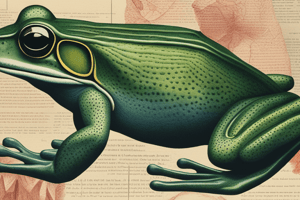Podcast
Questions and Answers
What is the primary basis for grouping plants and animals?
What is the primary basis for grouping plants and animals?
- Habitat
- External characters (correct)
- Diet
- Color of the organism
All living organisms can attain the same shape and size.
All living organisms can attain the same shape and size.
False (B)
What term is used to describe the external features of plants and animals?
What term is used to describe the external features of plants and animals?
External morphology
A ______ plant will differ from a banyan tree in both shape and size.
A ______ plant will differ from a banyan tree in both shape and size.
Match the following organisms with their characteristics:
Match the following organisms with their characteristics:
Which type of root develops directly from the radicle?
Which type of root develops directly from the radicle?
All plants have a primary root that is well developed.
All plants have a primary root that is well developed.
What is the main axis of a true root system called?
What is the main axis of a true root system called?
The part of the plant that remains above the soil is called the ______.
The part of the plant that remains above the soil is called the ______.
Match the following root types with their descriptions:
Match the following root types with their descriptions:
Flashcards are hidden until you start studying
Study Notes
Basic External Features of Plants and Animals
- Living beings on Earth are divided into two primary categories: plants and animals.
- External morphology refers to the study of external features, crucial for understanding the differences among organisms.
- Example: Angiospermic plants differ fundamentally from animals in shape and size.
Parts of Angiospermic Plants
- The root is the underground part anchoring the plant, while the shoot refers to the above-ground portion.
Definition and Types of Roots
- Roots develop from the radicle, which can be classified into two main types:
- True Root: Develops directly from the radicle (e.g., taproot).
- Adventitious Root: Forms from other plant parts (e.g., fibrous roots).
Taproot Structure
- Composed of the primary root that grows downward, typical in dicotyledons.
- Secondary roots branch from the primary root, producing a complex root system beneficial for stability and nutrient uptake.
Fibrous Root Structure
- Characterized by a cluster of roots emerging from the stem base, common in monocotyledons.
- Retains a weak or non-existent primary root structure, relying on new roots for anchorage.
Root Characteristics
- Grows downwards (positively geotrophic) and is colorless, lacking chlorophyll.
- Root hairs are found behind the root tip, aiding in water and nutrient absorption.
- Roots are negatively phototropic, growing away from light and positively hydrotrophic, growing towards water.
Regions of Taproot and Functions
- Five distinct regions in a young taproot:
- Root cap region: Protects the root apex from soil interference.
- Meristematic region: Site of active cell division, renewing root cap.
- Region of elongation: Cells grow in length, increasing overall root length.
- Root hair region: Contains one-celled root hairs for absorption.
- Permanent region: Where lateral branches form.
Stem Functionality and Structure
- The stem is the central axis of the shoot system, supporting branches, leaves, flowers, and fruits.
Parts of the Stem
- Node: Point where leaves emerge.
- Internode: Area between nodes.
- Leaf: Flat extension of the stem responsible for photosynthesis and transpiration.
Buds
- A condensed shoot system containing immature leaves, with axillary buds linked to branching and apical buds aiding stem elongation.
Stem Characteristics
- Develops from the plumule, grows upward, and contains chlorophyll.
- Stems exhibit positive phototropism (grow towards light) and negative hydrotropism (grow away from water).
Types of Stems
- Herbs: Soft and tender, completing their life cycle in varying durations (ephemerals, annuals, biennials, perennials).
- Shrubs: Medium-sized with woody branches that arise near the base, often bushy in nature.
- Trees: Tall, woody structures with a trunk. They can be categorized based on branching (branched or unbranched) and leaf retention (evergreen or deciduous).
Functions of the Stem
- Mechanical: Supports the weight of the plant.
- Physiological:
- Synthesizes food with chlorophyll.
- Conducts water and nutrients throughout the plant.
- Stores surplus food for future needs.
Studying That Suits You
Use AI to generate personalized quizzes and flashcards to suit your learning preferences.




